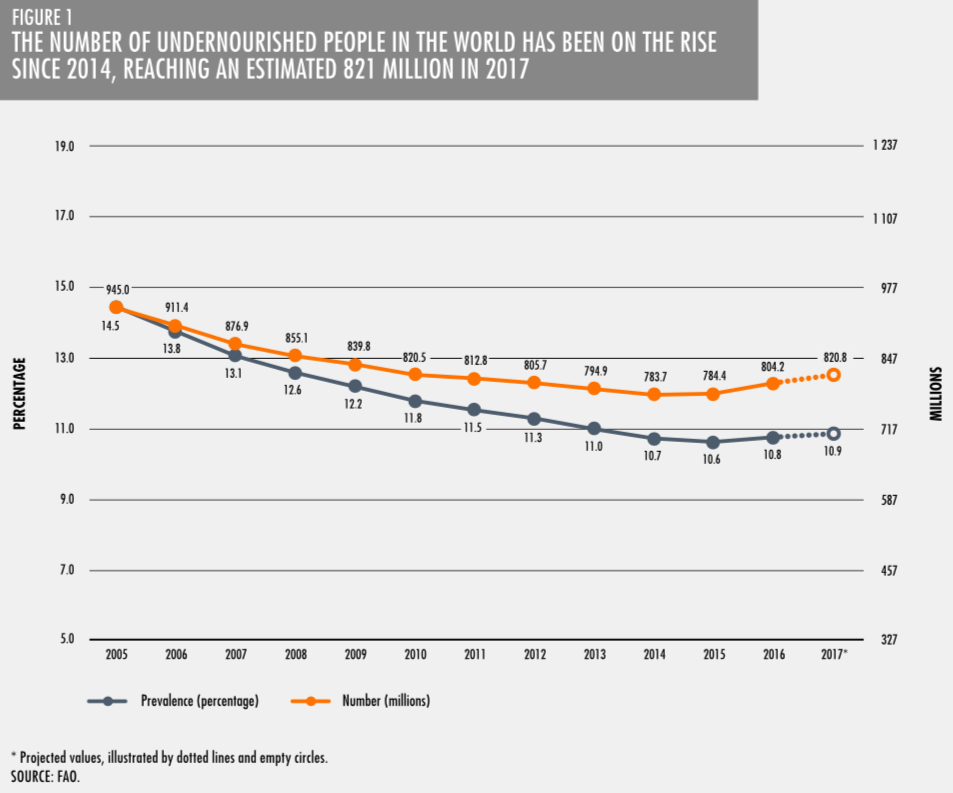

The number of hungry people in the world has reverted to levels last seen a decade ago, the United Nations warned Tuesday in its
annual report on food security and nutrition.
Nearly 821 million global citizens—or one out of every nine people—were undernourished in 2017, the third consecutive rise since 2015. Hunger affected 804 million people in 2016 and 784 million people in 2015.
Hunger worsened in South America and most regions of Africa, while decreasing trends in undernourishment in Asia has slowed down, the report shows.

According to the report, the “key drivers” behind the rise in hunger include climate variability, which affects rainfall patterns and agricultural seasons, as well as climate extremes such as droughts and floods. Conflict and economic slowdowns also contributed to the increasing undernourishment.
Climate change has already been shown to
undermine production of staple crops such as wheat, rice and maize in tropical and temperate regions, and the predicted rise in global temperatures will worsen output even further.
Notably, the study shows that the countries that are the most exposed to climate extremes tend to have a higher prevalence and number of undernourished people.
The report only covers the year 2017 and does not take 2018’s record-breaking heatwaves, flooding and wildfires into account.
Robin Willoughby, head of food and climate policy at Oxfam GB, told The Guardian that the extreme weather in the last few months has likely made global hunger worse.
“The extreme weather we have seen this year is likely to have exacerbated the crisis,” he said. “A hotter world is proving to be a hungrier world.”
The report also showed that obesity is on the rise, with more than one in eight adults in the world considered obese. The problem is the most significant in North America, but Africa and Asia are also experiencing an upward trend, the report shows.
Obesity is also a form of malnutrition. As a press release for the report points out: “Undernutrition and obesity coexist in many countries, and can even be seen side by side in the same household. Poor access to nutritious food due to its higher cost, the stress of living with food insecurity, and physiological adaptations to food deprivation help explain why food-insecure families may have a higher risk of overweight and obesity.”
The rising rates of global hunger threatens the UN’s Sustainable Development
Goal (SDG) of ending all forms of hunger and malnutrition by 2030.
“The alarming signs of increasing food insecurity and high levels of different forms of malnutrition are a clear warning that there is considerable work to be done to make sure we ‘leave no one behind’ on the road towards achieving the SDG goals on food security and improved nutrition,” the heads of the UN Food and Agriculture Organization, the International Fund for Agricultural Development, the UN Children’s Fund, the World Food Program and the World Health Organization warned in the report’s joint foreword.
The leaders also issued a call to action to break the cycle of malnutrition.
“If we are to achieve a world without hunger and malnutrition in all its forms by 2030, it is imperative that we accelerate and scale up actions to strengthen the resilience and adaptive capacity of food systems and people’s livelihoods in response to climate variability and extremes,” they said.
How Climate Change and Wars Are Increasing World Hunger https://t.co/gFj5beipXM @envirowire @OneWorld_News
— EcoWatch (@EcoWatch) October 19, 2017

 233k
233k  41k
41k  Subscribe
Subscribe 